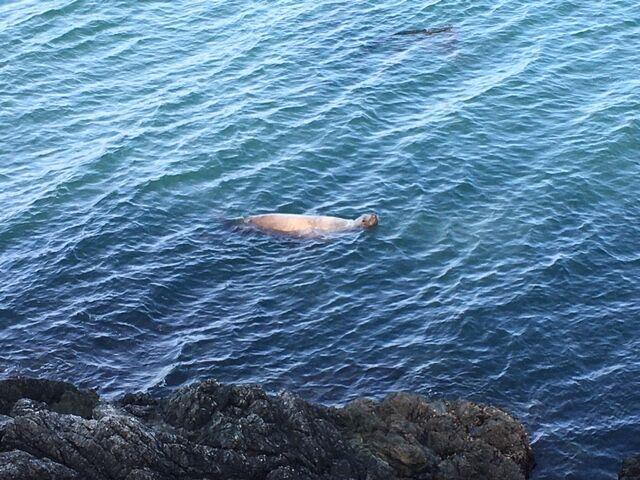
ANACORTES — Much to the relief of Biz Point residents who had been monitoring a seemingly lethargic Steller sea lion over the weekend, the animal was seen feeding Sunday on a salmon before swimming off.
“Our neighbors said that as the tide went out, she climbed over the rocks herself and was able to dive twice,” Ruth Backlund said Monday. “That’s what we were worried about, that she would not been able to dive and feed.”
As of late Monday morning, the sea lion — last seen resting in a tidepool — had apparently returned to sea.
While the Steller sea lion’s story had a happy ending — the animal even got a name from neighbors: “Stella” — Garry Heinrich of the Central Puget Sound Marine Mammal Stranding Network said the Backlunds did the right thing by contacting the stranding network.
“We want to know everything," he said. "The more we know, the more we can talk with and educate folks. It eases people’s minds, and it helps the animals.”
The Backlunds called the stranding network Friday, concerned that the sea lion had been injured. They had heard boats in Burrows Bay the previous night, followed by a sudden grunting sound, which Ruth Backlund described as “like that of a pig.” The following morning, the sea lion was seen floating with the tide, at one time partially beaching on rocks.
The sea lion didn’t seem to be making an effort to swim, dive or feed, the Backlunds said. In fact, it didn’t seem to do anything except to lift its head periodically for air.
Heinrich and a biologist from the National Oceanographic and Atmospheric Administration were on Camano Island that day investigating the death of a gray whale that had washed ashore, but studied photos and video emailed to them by the Backlunds and determined the sea lion was OK. There were no signs of injury, and the animal did not appear to be in distress.
“It looks like it was just hanging out,” Heinrich said Monday. “It didn’t look like there was anything wrong. In fact, a neighbor reported that there was bird activity around the sea lion as it was feeding on some large fish. It can swim, it can find food. Life is good.”
San Juan Safaris reports that Steller sea lions are seen in this area from about September through May before they head north to rookeries in Alaska to breed.
Steller sea lions forage and feed primarily at night, consuming salmon, sand lance, eulachon, herring, rockfish, squid and octopus, according to NOAA.
“An adult female has very high energy demands — especially in the winter, when she must find enough food to feed herself and nurse her pup, possibly while pregnant with the next year’s pup,” NOAA's website states.
Other good news on the pinniped front: a population of northern elephant seals is developing in this area, Heinrich said Monday. A female elephant seal has been visiting the same beach on Whidbey Island since 2010 to molt and to give birth. Between 2014 and last month, she has given birth four times on the same beach, Heinrich said.
A one-year-old elephant seal that was born and tagged in California has been sighted on a beach at Fort Casey.
“The experts at NOAA are pretty excited,” Heinrich said. The reason: northern elephant seals were once hunted nearly to extinction. All northern elephant seals are descended from a population of fewer than 100 that existed a century ago on Guadalupe Island, Baja California, Mexico, according to the Marine Mammal Center near San Francisco, California. Today, the population is about 150,000 — 124,000 of which live in California waters — “and is probably near the size it was before they were over-hunted,” the center reported.
Elsie Mae, the northern elephant seal known by NOAA as No. 1285, has returned to Skyline to molt, Heinrich said. She made the news last year when she had to be escorted off the Old Salt’s parking lot, tried to get into an RV, and clambered onto the deck of a home.
Heinrich said Elsie Mae is again invading people’s spaces — a reminder of the consequences of someone, somewhere, having interacted with her when she was a pup. Heinrich reminds people to keep their distance from marine mammals.
It is against federal law to get within 50 yards of a seal or sea lion.
“Never feed or attempt to feed a seal or sea lion — it’s harmful and illegal,” NOAA states. “Close encounters with people can be harmful and continued disturbances may cause stress, including causing mothers to abandon their pups. You’re too close if an animal starts to stare, fidget or flee into the water. Even if you don’t see these reactions, keep yourself and your pets at least 50 yards away.”
Garry Heinrich, volunteer coordinator and investigator
Central Puget Sound Marine Mammal Stranding Network
949-233-2822
Mark Backlund MD
360-941-6401
Elephant seal, Steller sea lion, California sea lion,
April 27, 2021 at 03:56AM
https://ift.tt/3sUtBwb
Lethargic sea lion off Fidalgo Island appears OK, may have been resting - goskagit.com
https://ift.tt/2CoSmg4
Sea
/cloudfront-us-east-2.images.arcpublishing.com/reuters/CZF6NULMVVMEXHOP7JK5BSPQUM.jpg)
No comments:
Post a Comment